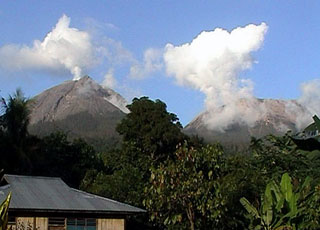Report on Lewotobi (Indonesia) — 24 January-30 January 2024
Smithsonian Institution / US Geological Survey
Weekly Volcanic Activity Report, 24 January-30 January 2024
Managing Editor: Sally Sennert.
Please cite this report as:
Global Volcanism Program, 2024. Report on Lewotobi (Indonesia) (Sennert, S, ed.). Weekly Volcanic Activity Report, 24 January-30 January 2024. Smithsonian Institution and US Geological Survey.
Lewotobi
Indonesia
8.542°S, 122.775°E; summit elev. 1703 m
All times are local (unless otherwise noted)
PVMBG reported that the eruption at Lewotobi’s Laki-laki volcano had decreased during 23-29 January based on visual and instrumental data. The lava flow on the NE flank continued to advance, reaching a length of 4 km, though the rate of advancement had slowed by 23 January, possibly due to gentler topography, a decrease in the effusion rate, or a combination of both. A total of 11 pyroclastic flows were detected and traveled 1-2 km N, NNE, and NE, though average distances were closer to 1 km. Eruption plume heights decreased from an average of 1.5 km above the summit to 500 m. The seismic network recorded a total of 388 lava avalanches that traveled as far as 1.5 km N and NE. Sulfur dioxide emissions significantly decreased, and deformation data indicated deflation. Analysis of deep volcanic earthquakes and low-frequency earthquakes both indicated a decrease in the supply of magma to the surface. At 1200 on 29 January the Alert Level was lowered to 3 (the second highest level on a scale of 1-4) and the public was warned to stay outside of the exclusion zone, defined as a 4-km radius around Laki-laki Crater, 5 km to the NNE, and 6 km on the NE flanks.
Geological Summary. The Lewotobi edifice in eastern Flores Island is composed of the two adjacent Lewotobi Laki-laki and Lewotobi Perempuan stratovolcanoes (the "husband and wife"). Their summits are less than 2 km apart along a NW-SE line. The conical Laki-laki to the NW has been frequently active during the 19th and 20th centuries, while the taller and broader Perempuan has had observed eruptions in 1921 and 1935. Small lava domes have grown during the 20th century in both of the summit craters, which are open to the north. A prominent cone, Iliwokar, occurs on the E flank of Perampuan.
Sources: Pusat Vulkanologi dan Mitigasi Bencana Geologi (PVMBG, also known as CVGHM), Antara News

